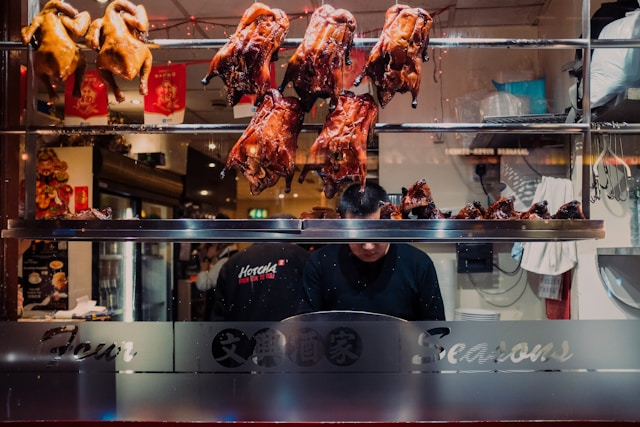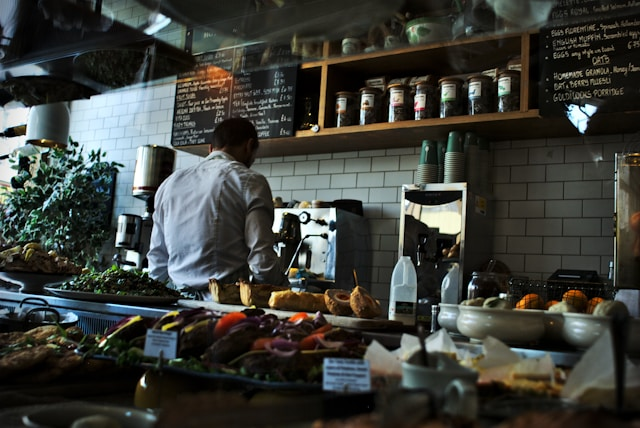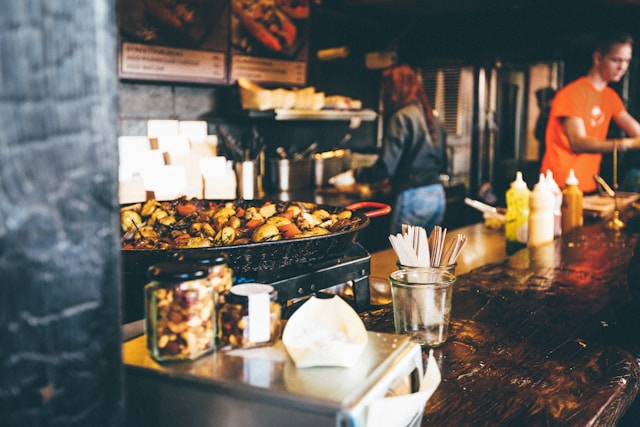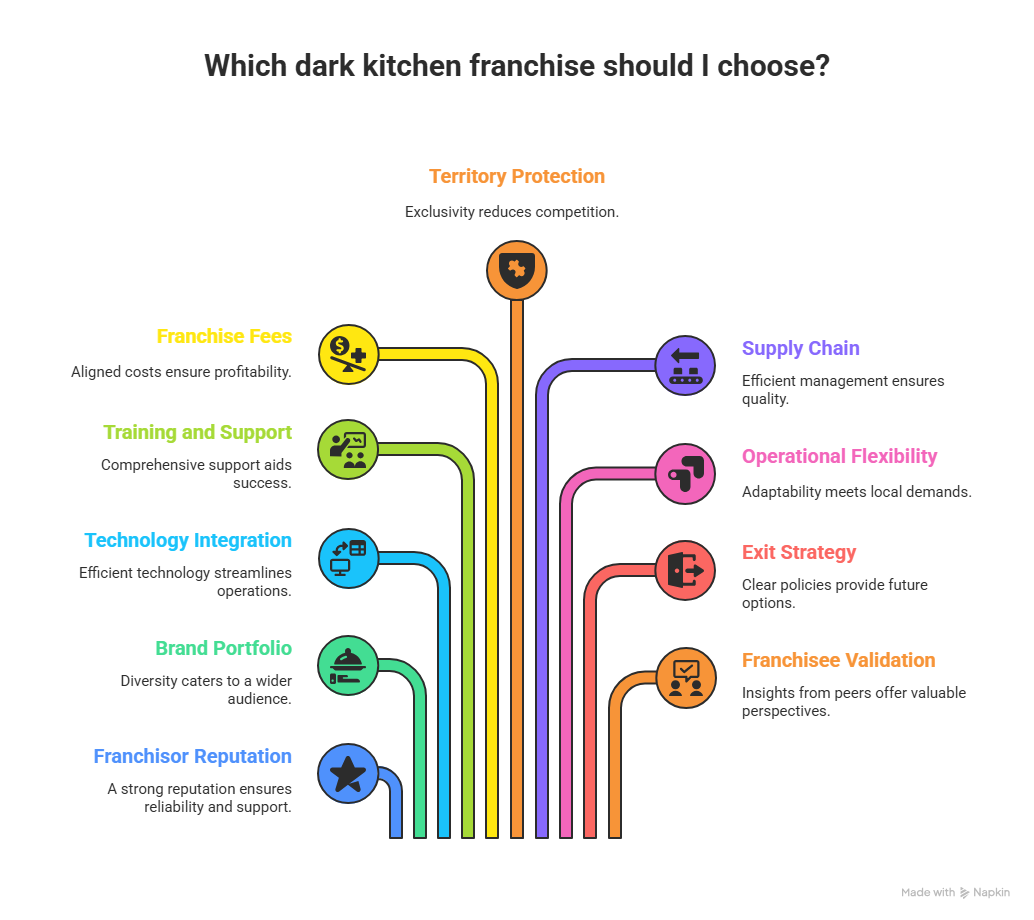.png)
Ever thought of restaurant profits, without the restaurant? Dark kitchens, also known as ghost kitchens or cloud kitchens, are leading the charge. These delivery-only setups eliminate the need for dine-in space, cutting overhead costs by up to 60% and offering a faster, leaner path to profitability.
In fact, the global cloud kitchen market is expected to hit $177.85 billion by 2032, and food delivery alone is on track to reach 24 billion U.S. dollars in 2026. This model offers strong growth potential. In India, rising real estate costs and changing consumer habits are accelerating the shift toward delivery-focused businesses.
If you're eyeing a food venture in 2025, a dark kitchen franchise could be your smartest move—low overhead, high scalability, and instant access to a delivery-first audience.
This guide walks you through everything: how it works, what it costs, and how to make it profitable.
A dark kitchen franchise operates exclusively for online food delivery. It lacks a traditional storefront or dining area. Instead, it focuses solely on food preparation for off-premise consumption.

As a franchisee, you gain access to a proven business model. You benefit from established recipes, branding, and marketing support. This structure allows for streamlined operations and reduced overhead.
Investing in a dark kitchen franchise offers several compelling advantages. You can capitalize on current market trends with reduced exposure. This model presents a high potential for return on investment.
With Kouzina's end-to-end cloud kitchen solutions, you can start your journey with a low investment and high returns. Explore how we can help you set up your kitchen today!
Also read: Starting A Small Restaurant Business In India 2024 Guide
To thrive in the dark kitchen franchise, implement strategic approaches. These will help you maximize efficiency and reach a wider customer base.

Location remains critical even without a storefront. Select an area with high population density and strong delivery demand.
Proximity to your target demographic is crucial for faster delivery times. Ensure the space complies with all local health and safety regulations.
Good logistical connectivity is also vital for delivery drivers.
Operating multiple virtual brands from one kitchen is a powerful strategy. This allows you to cater to a diverse range of tastes and cuisines.
For example, you could run a burger brand and a healthy bowls brand from the same kitchen.
This approach increases order volume and maximizes kitchen capacity. It appeals to a broader customer base.
With Kouzina’s multi-brand cloud kitchen model, you can operate several popular brands under one roof, cutting costs and increasing profits. Get in touch with us to learn more about our franchise opportunities!
Not all food travels well. Focus on dishes that maintain quality during transit. Consider packaging solutions that keep food at optimal temperatures. Keep your menu concise and specialized for each virtual brand.
A shorter menu simplifies inventory management and reduces food waste. High-quality food photography is essential for online menus.
Invest in robust technology solutions to streamline operations. A Kitchen Display System (KDS) manages order flow and preparation times.
A Point of Sale (POS) system centralizes orders and tracks sales. Utilize inventory management tools to avoid stockouts and reduce waste. AI and data analytics can predict demand and optimize staffing.
Most dark kitchen orders come through third-party delivery apps. Partner with major platforms like Uber Eats, DoorDash, and Swiggy.
Understand their commission structures and promotional opportunities. While these platforms are crucial, also consider developing a direct-to-consumer channel. This can reduce commission fees over time.
Even without a physical presence, branding is vital. Develop distinct branding for each virtual concept.
Use high-quality photos and clear descriptions on delivery platforms. Engage with customers through social media.
Encourage reviews to boost visibility and credibility. Implement loyalty programs to drive repeat business.
Your reputation hinges entirely on the quality and consistency of your food. Establish strict standard operating procedures (SOPs) for all dishes.
Train your kitchen staff thoroughly to ensure consistent preparation. Invest in high-quality ingredients and reliable equipment. Secure proper packaging to maintain food integrity during delivery.
Kouzina offers the perfect platform for independent chefs and aspiring entrepreneurs. Take advantage of our cloud kitchen setup, franchise model, and expert marketing support to build your dream food business. Start your cloud kitchen today with Kouzina!
Now that we understand the benefits, let’s examine the step-by-step process for launching a dark kitchen franchise.

The first step is choosing the right franchise. Look for a well-known brand with a proven track record. Check for:
Even without a dining space, location matters:
Efficiency is key in a dark kitchen. Here’s how to set it up:
A small, skilled team is all you need:
Though you’ll be on delivery platforms, marketing still matters:
Running smoothly is key to keeping costs down:
With these simple steps, you'll be ready to start a dark kitchen franchise in 2025, with a streamlined approach to success.
Read more: Starting a Food Franchise: A Step-by-Step Guide

Selecting the right dark kitchen franchise is a critical decision that will significantly influence your success. Consider these essential factors during your evaluation process:
A diverse portfolio allows you to cater to a broader customer base and adapt to evolving culinary trends. Consider the appeal of their existing brands to your target market.
Ensure the technology is robust, user-friendly, and capable of streamlining operations efficiently.
Look for continuous support, including marketing assistance, supply chain guidance, and operational troubleshooting.
Ensure these costs align with your budget and provide a reasonable return on investment. Compare these fees across different franchise opportunities.
The investment required for a dark kitchen franchise is typically lower than that of a traditional restaurant. However, various factors influence the total cost.
The total investment for a dark kitchen franchise can range between ₹15 lakhs and ₹50 lakhs, depending on the scale and franchise brand.
While the dark kitchen model offers a lean and scalable path to food entrepreneurship, it’s not without its challenges. Knowing what lies ahead—and how to handle it—can be the difference between early burnout and long-term success.
Dark kitchens have a low barrier to entry, which means the space is getting crowded. From international QSR giants to hyperlocal burger joints, everyone’s vying for customer attention. The key is to differentiate—whether through unique menu offerings, superior packaging, or standout digital branding.
Pro Tip: Develop a strong identity for each of your virtual brands. Keep menus focused, aesthetics sharp, and customer feedback loops active.
Zomato, Swiggy, and other aggregators offer reach, but at a cost. Commission rates can cut deep into margins, especially for newer operators.
How to balance it: Build your own direct ordering channel through a website or app to reduce dependency. Offer incentives like loyalty points or discounts for direct orders.
The customer experience begins at your kitchen—but it ends in their hands. Food that arrives soggy, spilled, or cold can hurt repeat orders.
What helps: Use durable, temperature-retaining packaging designed for travel. Limit menu items that don’t transport well and set SOPs for consistent quality under pressure.
In the absence of a dining space, you don’t get real-time feedback. That makes it harder to build rapport, trust, or loyalty.
Fix this digitally: Lean into reviews, social media engagement, and customer support. Use post-order surveys or automated follow-ups to gather insight and build relationships.
Managing multiple brands in one kitchen—especially during peak hours—demands tight coordination. From prep timing to dispatch accuracy, it all adds up fast.
Solution: Invest in a robust kitchen display system (KDS) and workflow tools. Train staff to handle simultaneous brand operations without mixing up orders or compromising speed.
Dark kitchens are still subject to FSSAI licensing, fire safety, health standards, and local zoning rules. Many overlook these early on, leading to penalties later.
Tip: Get legal and licensing assistance from your franchisor (if you’re working with one), and schedule regular compliance audits.
Choosing the right franchise partner is half the battle—and that’s where Kouzina Food Tech sets itself apart.
With Kouzina, you don’t just get a brand—you get an entire support ecosystem:
Start your cloud kitchen franchise journey with Kouzina today—fill out the form and we'll guide you from idea to launch.
The dark kitchen landscape will continue to evolve rapidly. Staying informed about future trends is essential for long-term success.
Utilizing AI and data analytics will enable even more personalized experiences. This includes tailored menu recommendations and customized promotions. The goal is to make each customer feel uniquely valued.
Increased adoption of automation in the kitchen is expected. This includes automated cooking equipment and robotic food preparation.
Automation can enhance efficiency and reduce labor costs. It ensures consistency in food production.
Consumers are increasingly demanding eco-friendly practices. Dark kitchens will focus more on sustainable sourcing and waste reduction. This includes compostable packaging and energy-efficient appliances. Green practices can become a significant differentiator.
Dark kitchens may integrate with other services, like grocery delivery. They could also combine with meal kit subscriptions.
This expands revenue streams and customer reach. The lines between various food services will continue to blur.
Expect an explosion of highly specialized virtual brands. These will cater to specific dietary needs or unique culinary preferences.
Examples include plant-based comfort food or keto-friendly options. This allows for targeting very specific market segments.
Launching a dark kitchen franchise in 2025 presents a low-risk, high-reward opportunity, particularly as the demand for online food delivery continues to increase. By choosing the right franchise, location, and operational strategies, you can build a profitable business with minimal overhead costs.
While it requires careful planning, research, and execution, the benefits of owning a dark kitchen franchise, such as scalability, flexibility, and cost efficiency, make it a promising option for entrepreneurs looking to enter the food industry.
With Kouzina’s expert support, you can build and scale your cloud kitchen franchise efficiently, even with an initial investment as low as ₹12-15 lakhs. Start your journey with Kouzina today—contact us to turn your food business dreams into reality!
Leap today, and start your dark kitchen franchise to tap into the booming food delivery market of 2025!
A dark kitchen franchise operates solely for delivery, with no physical dining space, allowing multiple brands to be housed under one roof for reduced costs.
The cost ranges from ₹15 lakhs to ₹50 lakhs, including franchise fees, kitchen setup, staffing, and marketing.
Yes, an FSSAI license is mandatory for all food businesses, including dark kitchens.
Yes, a dark kitchen franchise allows you to run multiple brands under one roof.
Look for a reputable brand, strong support, reasonable fees, and a menu that suits your target market.
No, dark kitchens operate solely for online orders and deliveries without a dining space.